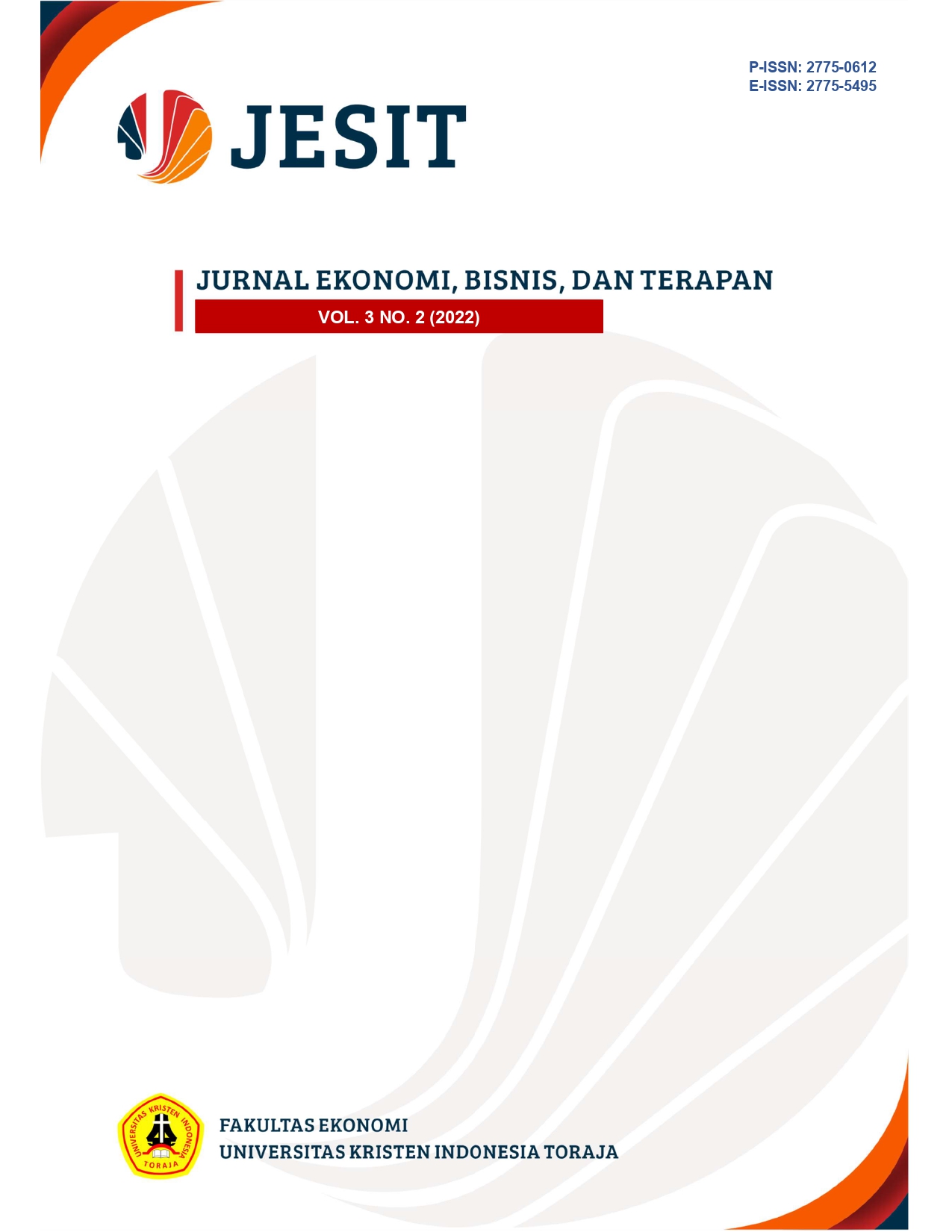Pengaruh Rasio Likuiditas, Solvabilitas,dan Profitabilitas Terhadap Harga Saham Pada Sektor Food And Beverages di Bursa Efek Indonesia
DOI:
https://doi.org/10.47178/jesit.v3i1.1656Abstract
Fundamental analysis is an approach most often used by investors to predict future stock price movements. An indicator that is often used by an investor in fundamental analysis is to look at the financial ratios in the financial statements issued by the company. This study aims to determine the effect of the Current Ratio, Debt To Equity Ratio, and Return On Equity on Stock Prices in the food and beverages sector on the Indonesia Stock Exchange. Sample determination was carried out using the Purposive Sampling method with research data obtained from financial statements for 5 years, namely the 2017-2021 period. The data analysis used is multiple linear regression analysis. The results of the t-test showed that the current ratio variable partially does not affect the stock price, the debt to equity ratio variable partially affects the stock price and the return on equity variable partially affects the stock price. The results of the F test, show that simultaneously the variable current ratio, debt to equity ratio, and return on equity simultaneously have an influence significant on stock prices.
Fundamental analysis is an approach most often used by investors to predict future stock price movements. An indicator that is often used by an investor in fundamental analysis is to look at the financial ratios in the financial statements issued by the company. This study aims to determine the effect of the Current Ratio, Debt To Equity Ratio, and Return On Equity on Stock Prices in the food and beverages sector on the Indonesia Stock Exchange. Sample determination was carried out using the Purposive Sampling method with research data obtained from financial statements for 5 years, namely the 2017-2021 period. The data analysis used is multiple linear regression analysis. The results of the t-test showed that the current ratio variable partially does not affect the stock price, the debt to equity ratio variable partially affects the stock price and the return on equity variable partially affects the stock price. The results of the F test, show that simultaneously the variable current ratio, debt to equity ratio, and return on equity simultaneously have an influence significant on stock prices.
Downloads
References
Brigham, F., & Houston, J. F. (2014). Dasar-Dasar Manajemen Keuangan “Essentials Of Financial Management” (pp. 1–486). Salemba Empat.
Darmadji, & Fakhruddin, H. . (2012). Pasar Modal di Indonesia. Salemba Empat.
Fitri, S. A., & Yahya, Y. (2016). Pengaruh Kinerja Keuangan Terhadap Harga Saham Perusahaan Food and Beverages Di BEI. Jurnal Ilmu Dan Riset Manajemen, 5(4), 1–16.
Fitrianingsih, D., & Budiansyah, Y. (2019). Pengaruh Current Rasio Dan Debt To Equity Ratio Terhadap Harga Saham Di Perusahaan Food and Beverage Yang Terdaftar Di Bursa Efek Indonesia Periode 2013 – 2017. Jurnal Riset Akuntansi Terpadu, 12(1), 144–166. https://doi.org/10.35448/jrat.v12i1.5347
Ghozalli, I. (2013). Aplikasi Analisis Multivariate dengan Program SPSS Edisi Ketujuh. Universitas Dipenogoro.
Hanafi, M. M. (2018). Manajemen Keuangan Edisi 2 (pp. 1–716). BPFEYOGYAKARTA.
Hartono, J. (2013). Teori Portofolio dan Analisis Investasi Edisi Kedelapan. BPFE Yogyakarta.
OJK. (2019). Buku 3 Pasar Modal "Seri Literasi Keuangan Perguruan Tinggi. 1-270.https://sikapiuangmu.ojk.go.id/FrontEnd/LiterasiPerguruanTinggi/
Putri, V. A., & Yustisia, N. (2021). Dampak Rasio Keuangan Terhadap Harga Saham Perusahaan Barang Konsumsi yang Terdaftar di Bursa Efek Indonesia. Jurnal Studi Islam Dan Sosial, 2(1), 1–16.https://lisyabab-staimas.ejournal.id/lisyabab/article/view/71
Rahmi, N. U., Andrew, A., Stefani, A., & Fenita, F. (2021). Analisis Rasio Keuangan terhadap Harga Saham pada Perusahaan Food and Beverages. Owner Riset & Jurnal Akuntansi, 5(2), 380–395.https://doi.org/10.33395/owner.v5i2.481
Ramadhana, A. A., Herman, S., & Purnomo, S. H. (2018). Pengaruh Kinerja Keuangan Terhadap Harga Saham. Jurnal Organisasi Dan Manajemen, 1(1), 47–64. https://doi.org/10.37641/jimkes.v1i1.254
Rumawi, R., Lestari, A. S., Saija, R., Satriawan, D. G., Bancin, J. B., Berlianty, T., Kuahaty, S. S., Atikah, I., Sakirah, S., Hasibuan, A. K. H., Sinaga, L. V., Nababan, J. F., Dharma, E., & Ihwanudin, N. (2021). Hukum Pasar Modal. Widina Bhakti Persada Bandung.
Sadeli, H. L. M. (2018). Dasar-Dasar Akuntansi (pp. 1–186). PT. Bumi Aksara.
Spence, M. (1973). Job Market Signaling. The Quarterly Journal of Economics, 355–374.
Sugiyono, S. (2017). Metode Penelitian Bisnis “Pendekatan Kuantitatif, Kualitatif, Kombinasi dan R&D” (pp. 1–818). Alfabeta Bandung.
Sugiyono, S. (2019). Metode Penelitian Kuantitatif Kualitatif dan R&D (pp. 1–444). Alfabeta Bandung.
Sujarweni, V. W. (2015). Akuntansi Sektor Publik (pp. 1–240). Pustaka Baru Press.
Sunyoto, D. (2013). Metodologi Penelitian Akuntansi (pp. 1–188). PT. Refika Aditama.
Supriadi, Y., & Arifin, M. (2013). Pengaruh Kinerja Keuangan Terhadap Harga Saham. Jurnal Ilmiah Manajemen, 1(1), 53–68. https://doi.org/https://doi.org/10.37641/jimkes.v1i1.254
Tresnasari, D., & Triyonowati. (2019). Pengaruh Kinerja Keuangan terhadap Harga Saham pada Sektor Food and Beverages. Jurnal Ilmu Dan Riset Manajemen, 8(2), 1–18. http://jurnalmahasiswa.stiesia.ac.id/index.php/jirm/article/view/870
Utari, D., Purwanti, A., & Prawironegoro, D. (2014). Manajemen Keuangan Edisi Revisi “Kajian Praktik dan Teori Dalam Mengelola Keuangan Organisasi Perusahaan” (pp. 1–414). Mitra Wacana Media.
Wiyono, G., & Kusuma, H. (2017). Manajemen Keuangan Lanjutan Berbasis Corporate Value Creation (pp. 1–438). UPP STIM YKPN









